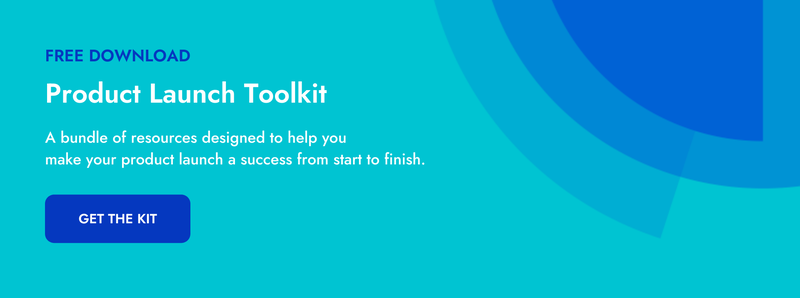Right off the bat, let’s make sure we’re on the same page in terms of definitions.
In its simplest form, a market consists of buyers and sellers. Technically, we could also include suppliers, partners, regulators—but that’s an unnecessary level of complexity for this blog post.
Market research, therefore, is the process of gathering information about the buyers and sellers within a given market. Meanwhile, product development is the process of conceptualizing, creating, and launching a product. It begins with ideation, and it … well, it never really ends. The “final” stage of product development is iteration.
Simply put, it’s extraordinarily difficult to launch a successful product without conducting some form of market research. At a minimum, you need to know what drives your prospects, who you’re competing with, and how those competitors position themselves to your shared audience.
Cool? Cool. Now, let’s discuss three ways your company (or business unit) can use market research throughout the process of conceptualizing, creating, and launching a new product:
- To generate your initial ideas (conceptualizing)
- To work out the kinks before you launch (creating)
- To optimize your messaging (launching)
1. Generate your initial ideas (conceptualizing)
Some products are happy accidents. In the mid-20th century, a Canadian engineer named John Hopps “serendipitously observed that an electrical impulse would cause the heart to contract and that repetitive stimuli would allow this to occur over a prolonged time.”
It’s a remarkable story. But, alas, we can’t all be John Hopps; we can’t all rely on serendipity. What you can rely on is data. Specifically, you can use primary and secondary data to identify pain points—which, in turn, can spark initial ideas for new products.
As an example, let’s say you work for an education solutions company that’s known for helping teachers with math instruction. This specialization has served the brand well up until this point, but the time has come to branch out—and you’ve been tasked with leading the effort to develop the company’s new breakthrough product.
In this case, you could gather primary data by surveying teachers and administrators at the schools that already use your company’s existing solutions. Outside of math, in what subject are students finding the most difficulty? What specific roadblocks make this subject so difficult? Do students tend to respond particularly well to certain methods of instruction, such as animated videos or hands-on activities? Answers to questions like these can help build the foundation of your team’s early brainstorms.
Of course, it’s often wise to supplement primary data with secondary data. In the education world—and many other industries—government websites are gold mines of free information. Here in the U.S., the Department of Education has dedicated an entire section of their website to data and statistics. By synthesizing third-party quantitative research with your own qualitative research, you and your team can get a strong sense of what students are struggling with—and use that as a launchpad for early ideation.
The takeaway
Although you probably don’t work for an education solutions company like the hypothetical one we’ve described, the point remains: Identifying pain points helps to jumpstart the product development process, and your team can do it by (1) interviewing customers and (2) diving into data that other organizations have already gathered.
Competitive best practice
For each of your initial ideas, do a quick Google search to get a sense of what your future competitive landscape may look like. Is it a crowded space? How are existing sellers differentiated from one another? Is there a lot of hype surrounding this industry? The sooner you adopt a competitive mindset, the better.
2. Work out the kinks before you launch (creating)
Let’s fast forward. At this point in the product development process, you and your team have settled on a problem that needs to be solved and begun working on a potential solution.
Once again, an example is useful here. Say you work for a pet supplies company. One of the company’s most lucrative product lines is a variety of cat litters, and through your initial market research, you’ve identified a major pain point: Disposing of used cat litter is a hassle—and it often feels unsanitary. As such, your team has created a prototype of a device that purports to enable quick, clean, and odorless disposal.
Although you know for a fact that litter disposal is a pain point amongst your target audience, you do not know for a fact that consumers will find success with your new product. And that’s where prototype testing comes in.
Prototype testing is the process of observing people as they use your prototype and collecting their feedback on the user experience. The goal, of course, is to identify any issues that need to be remedied before moving forward in the development process. Ultimately, prototype testing enables you to learn more about your prospects’ tendencies and preferences and, in turn, create the best solution possible. Oh—and it saves your company a lot of money in the long run.
Sticking with our example of the litter disposal device, issues that may be identified through prototype testing include:
- Unintuitive design
- Insufficient odor protection
- Lack of durability
Different types of companies practice prototype testing in different ways; using a cat litter disposal device and using an email marketing tool are two very different experiences. In general, however, it’s critical to choose the right audience. As product design expert Caitlin Goodale says, “you want a diverse group of testers [that reflect] the different personas within your product—as well as people who are not currently users but might become them.”
The takeaway
Although you’re probably not in the cat litter business, the point remains: Knowing what to solve is one thing; knowing how to solve it is another. Working out the kinks prior to launch day is an essential step towards creating a successful product, and your team can do it by observing people as they engage with early iterations.
Competitive best practice
If public customer reviews are available in your industry, make sure to check them out; at this stage, negative reviews are particularly valuable. Do you see any flaws across each of your competitor’s products? Any defects that drive buyers in this market crazy? If so, pay special attention to these details when testing your prototype. For example, if several competitors have gotten complaints about durability, you’d better make sure you’re testing all the different ways your prototype could potentially suffer damage.
3. Optimize your messaging (launching)
Let’s fast forward one more time. At this point in the product development process, you and your team are putting the finishing touches on a product that’s ready to launch.
This time, let’s say your company is known for selling technical content management software to manufacturers. In the earliest stages of product development, you learned that translating documentation into different languages is a major pain point. After months of building, testing, and tweaking, your team is just about ready to introduce your translation solution to the world.
Although you know for a fact that your new product is a viable solution to the translation problem, you do not know for a fact that prospects will be drawn to it. And that’s where message testing comes in.
To be clear, message testing—the process of determining which marketing messages are most effective amongst your target audience—is not strictly a pre-launch exercise. In fact, message testing can and should take place well after a product has been brought to market. For the purposes of this blog post, however, we’ll focus on pre-launch message testing.
Pre-launch message testing entails the collection of qualitative feedback from both internal stakeholders—your colleagues—and external stakeholders—your customers. Whereas the former group is intimately familiar with your brand’s overarching identity and story, the latter group is intimately familiar with the challenges that your new product purports to address.
Issues that may be identified through pre-launch message testing include:
- Misalignment with your company’s brand promise
- Unclear value proposition
- Insufficient differentiation from other solutions
Again, message testing can and should be conducted throughout the product life cycle. But pre-launch testing in particular is important because it gives your new product a better chance of succeeding right out of the gate—which, in turn, boosts employee morale, improves brand authority, and enables immediate feedback collection.
The takeaway
Chances are your company has nothing to do with translation, but it doesn’t matter: Even the strongest of products cannot survive lackluster marketing. Optimizing your messaging prior to launch day makes immediate success all the more attainable, and your team can do it by tapping the minds of colleagues and customers alike.
Competitive best practice
If the product you’re launching is not the first of its kind, take note of how your competitors position and promote their alternatives. And if the product you’re launching is the first of its kind—but your company has competitors within other business units—you should still take note of your competitors’ marketing strategies. Even if they don’t offer direct alternatives to your new product, they’re probably still on your prospects’ radars in some capacity.
Using real-time market data to optimize product development
Want access to competitive intelligence as soon as you start conceptualizing a new product? Want a centralized repository of every customer review across your industry? Want side-by-side snapshots of changes to your competitors’ positioning and messaging?
That’s only scratching the surface of what’s offered by Crayon—the award-winning competitive intelligence platform that enables you to track, analyze, and act on everything happening outside the four walls of your business. Request a demo today, and start competing like you mean it.

Related Blog Posts
Popular Posts
-
 The 8 Free Market Research Tools and Resources You Need to Know
The 8 Free Market Research Tools and Resources You Need to Know
-
 How to Create a Competitive Matrix (Step-by-Step Guide With Examples + Free Templates)
How to Create a Competitive Matrix (Step-by-Step Guide With Examples + Free Templates)
-
 6 Competitive Advantage Examples From the Real World
6 Competitive Advantage Examples From the Real World
-
 24 Questions to Consider for Your Next SWOT Analysis
24 Questions to Consider for Your Next SWOT Analysis
-
 How to Measure Product Launch Success: 12 KPIs You Should Be Tracking
How to Measure Product Launch Success: 12 KPIs You Should Be Tracking





